Animal Nutrition- Exam 2
1/151
There's no tags or description
Looks like no tags are added yet.
Name | Mastery | Learn | Test | Matching | Spaced |
|---|
No study sessions yet.
152 Terms
What are monogastrics?
Nonruminants have single stomach compartments
Why do animals with a small stomach volume relative to their body size need frequent feeding and concentrated rations low in bulk and fiber?
Because their small stomach cannot hold large amounts of bulky feed, they must eat more often and rely on nutrient-dense rations that provide sufficient energy without excessive fiber.
What is the monogastric digestive tract? (Ex: pigs)
Mouth → esophagus→ simple stomach → small intestine (duodenum, jejunum, ileum) → large intestine → rectum → anus

What is the digestive pathway of poultry?
Mouth→ esophagus→ crop → proventriculus (stomach) → gizzard → small intestine → (ceca) → large intestine→ cloaca → vent
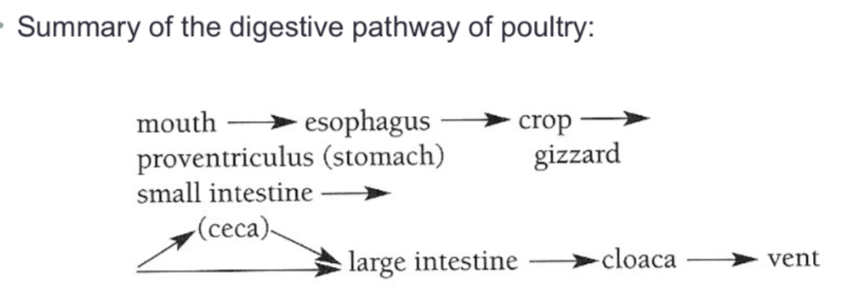
What is the function of the small intestine?
Major site of digestion and nutrient absorption. Composed of the duodenum, jejunum, and ileum. Those 3 areas receive secretions of the liver, pancreas, and cells within the walls of the small intestine.
What is the function of the large intestine?
It absorbs water, dry out ingestible foods, and eliminate waste products. Divided into large and small colon.
What is the crop?
A pouch in the esophagus used to store food temporarily before moving to stomach
What is the proventriculus?
The glandular stomach because it produces HCl and digestive enzymes
What is the gizzard?
the muscular part of the stomach that uses grit to grind grains and fiber into smaller particles
What are the two parts of the stomach in poultry?
Proventriculus and gizzard
What is the ceca (in poultry)?
Bacterial action helps break down undigested food passing through the intestine.
What is the cloaca (in poultry)?
bulblike structure at the end of the
digestive tract where the digestive, urinary and
reproductive systems meet.
What is the vent (in poultry)?
external opening of the cloaca that
passes waste to the outside
Why are ruminants important to humanity?
Cattle, sheep, goats, buffalo, deer, elk, etc.. can convert fibrous feeds into meat, milk and fiber without directly competing with the human
food supply
What are the 4 functional stomach compartments in mature ruminants?
Rumen, Reticulum, Omasum, Abomasum (true stomach)
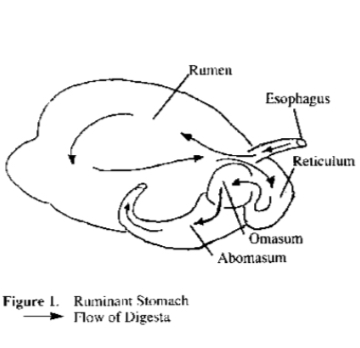
What is the rumen?
The first and largest of the 4
compartments. The site of active microbial
digestion
What is the reticulum?
The second compartment, where microbial digestion continues
What is the omasum?
The third compartment, receives material from the reticular-omasal orifice
What is the abomasum?
The true stomach, The fourth
compartment. Corresponds to the stomach
of nonruminants. Where enzymatic
digestion occurs
Why are young ruminants considered functionally nonruminants?
Because their first three stomach compartments are small, and a special esophageal groove directs milk straight to the omasum and abomasum for digestion.
Ruminants swallow ingested feed immediately. What happens after?
They lie down to initiate rumination, or “chewing their cud” (can last 8< hrs)
What is the process of rumination?
Rumination involves the processes of regurgitation, reensalivation, remastication and reswallowing of earlier Ingested rumen materials
What is the function of the rumen, and how does enzymatic digestion occur there?
The rumen acts as a large fermentation vat. It produces no digestive enzymes, and ruminant saliva lacks carbohydrases. Digestion is carried out by bacterial and protozoal enzymes.
What is the near-idea, environment for the rumen for enormous numbers of microorganisms?
warm temperature, adequate
moisture, nutrients from the feed, a suitable pH, largely anaerobic conditions, etc
In return, what do the microorganisms in the rumen do?
Convert large amounts of starch and cellulose to colatile fatty acids as sources
of energyConvert both preformed protein and nonprotein nitrogen to microbial protein,
which serves as a source of protein containing all the essential amino acidsSynthesize vitamin K and all of the B vitamins
How is digestion in horses and mules unique compared to ruminants and nonruminants?
Horses are not either ruminants or nonruminants. Their small-intestine digestion is similar to pigs (nonruminants), but they can also digest forages because of microbial fermentation in the cecum and large intestine
What is the cecum?
A large blind sac that is located between the small intestine and the large colon
What materials are fermented in the large intestine?
Mainly fibrous residues and other materials that escape enzymatic digestion in the stomach and small intestine.
what is the principal end product of bacterial fermentation?
volatile fatty acids (VFAs) which provide up to 25% of the animal’s energy needs
What are volatile fatty acids?
The group of volatile organic acids resulting from
fermentation; most prevalent are acetic, propionic, and butyric acids
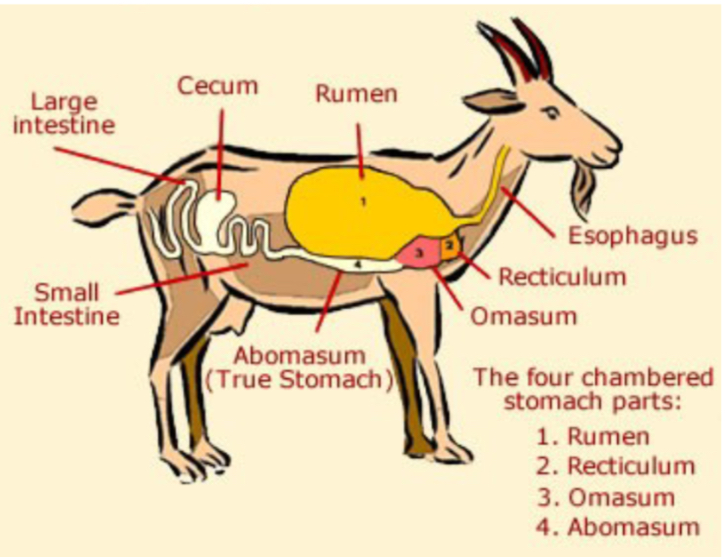
What is the digestive pathway of ruminants?
Mouth → esophagus→ reticulo-rumen (regurgitated, rechewed, reensalivated, reswallowed) → omasum → abomasum → small intestine → (cecum) → large intestine → rectum → anus
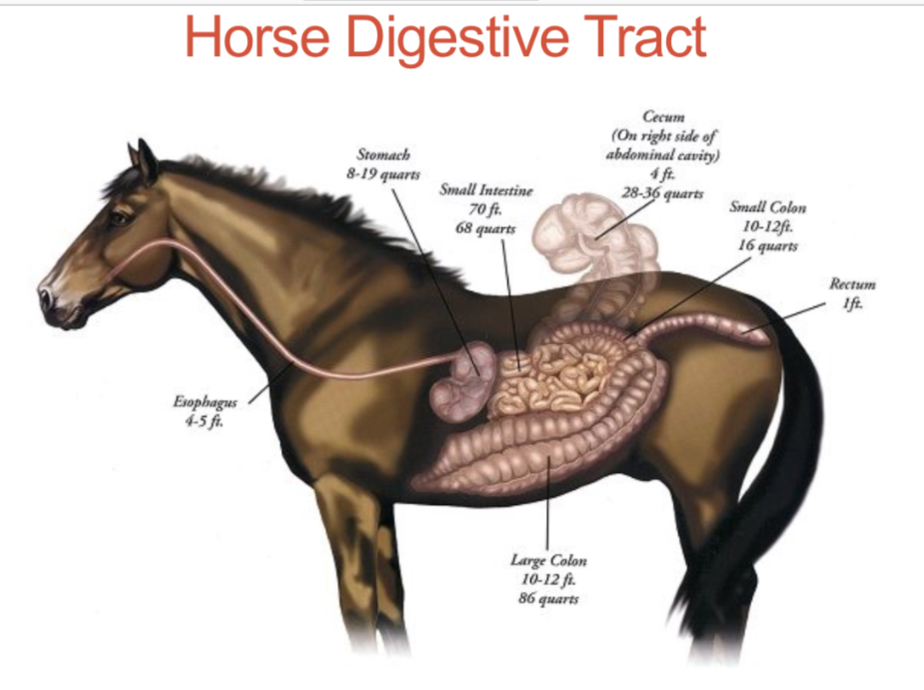
What is the digestive pathway of a horse?
Mouth → esophagus → simple stomach → small intestine → (cecum) → large intestine → rectum → anus
What are the two types of disease?
Noninfectious and Infectious
What are some noninfectious diseases?
Certain genetic abnormalities
• Nutritional deficiencies (such as anemia)
• Metabolic diseases (such as pregnancy toxemia)
• Poisoning (such as lead)
What are some infectious diseases caused by?
• Viruses
• Bacteria
• Fungi
• Protozoa
• Internal/external parasites
What can cause nutritional deficiencies?
Low level of nutrients in soil, low ration in feed, blocked metabolism, etc.
What are the 2 types of deficiencies?
Acute/Severe Deficiency and Borderline Deficiency
What is acute/severe deficiency?
it happens quickly, often after a sudden drop in intake or increased need. the deficiency is extreme enough to significantly impair normal body function.
What is borderline deficiency?
lower than optimal but not low enough to cause obvious clinical symptoms
What is water concentration determined by?
solute concentration because solute
particles displace water molecule
What is osmolarity?
The measure of total concentration of solute particles
What is an isotonic solution?
A solution with the same solute concentration as that of the cytosol = no net movement of water
What is a hypertonic solution?
A solution having greater solute concentration than that of the cytosol = water will leave the cell
What is a hypotonic solution?
A solution having lesser solute concentration than that of the cytosol = water will enter cel
How do animals compensate for passive ion and water movements?
active transport of ions across osmoregulatory epithelia (oe= gills, kidney, digestive system)
Fish in freshwater…
Passively gains water and loses ions across gill and gut.
Produces dilute urine in kidney to get rid of water.
Actively absorbs ions at gill = using ATP.
Fish in seawater…
Passively loses water and gains ions across gill and gut.
Cannot produce concentrated urine to conserve water.
Drinks to obtain water.
Actively secretes ions at gill = using ATP.
Reptiles/Birds have Salt glands. What are they?
glands near the eyes that excrete excess salt, allowing seabirds to drink seawater and maintain osmoregulation.
Sharks are osmoconformers but ionoregulators. What is this?
Cannot produce concentrated urine to conserve water.
Blood is kept slightly hyperosmotic to environment.
Water enters passively at gills.
How do terrestrial and desert mammals conserve water?
Produce concentrated urine with efficient kidneys.
Lose water to air but replace it by eating and drinking.
Desert mammals survive with minimal freshwater by having highly efficient kidneys.
What are the 5 homeostatic functions of the urinary system?
1. Regulates blood volume and blood pressure: by adjusting volume of water lost in urine.
2. Regulates plasma ion concentrations: by controlling quantities lost in urine; Calcium ion levels.
3. Helps stabilize blood pH: by controlling loss of hydrogen ions and bicarbonate ions in urine. If I have an increase in H+ --- pH decreases = acidic.
4. Conserves valuable nutrients: by preventing excretion while excreting organic waste products = things like glucose, ammonia waste ie Urea, ammonia = protein catabolism; proteins/amino acids.
5. Assists liver in detoxifying poisons = medications, drugs, ammonia/urea.
What is the loop of Henle?
Allows the production of concentrated urine
What animal does not have a loop of henle?
Fish
What does the mammalian kidney do?
Receives blood through renal artery and 20-25% of total cardiac output.
What happens before filtrate leaves the kidneys?
Useful materials are recaptured before filtrate leaves kidneys
Where does reabsorption occur?
In the proximal convoluted tubule
What are the transport methods for reabsorption?
Diffusion, Osmosis, Channel-mediated diffusion, Carrier-mediated transport
What epithelia are involved in both ion/water balance and nitrogenous waste excretion?
Epithelia in gills and kidneys regulate ions and water, and also excrete nitrogenous wastes like ammonia.
Why does the form of nitrogenous waste matter?
Nitrogen can be excreted as ammonia, urea, or uric acid, and the type affects ion and water balance by influencing how much water and energy is needed for excretion.
Ammonia produced during amino acid breakdown is toxic and must be excreted in what 3 ways?
Ammonia, Urea, and Uric Acid
What happens when amino acids or nucleic acids are deaminated?
They produce toxic ammonia, which diffuses easily into cells and must be eliminated from the body.
What are the features of ammonia/ammonium excretion?
Ammonia diffuses and ammonium uses exchangers, both are highly toxic and need lots of water to excrete, but they cost little energy to produce.
What are the multiple ways ammonia can be dealt with?
Conversion to urea, then transport out.
Volatilization of gas, diffusion out, then
evaporationNH4+ facilitated diffusion through a
channel, or active transportDiffusion trapping
What are the key features of urea as a nitrogenous waste?
Mammals excrete urea made in the liver via the ornithine-urea cycle; it costs more energy than ammonia, is less toxic but needs some water for excretion, and has similar metabolic costs to uric acid.
In many mammals, uric acid is the final what?
Oxidation product
Pro: few toxic effects
Con: expensive to produce
What is the summary of ammonia?
Aquatic organisms avoid ammonia poisoning by
dissolving it in large quantities of water.
Ammonia diffuses across the gill epithelium, skin or other permeable membrane bathed by water.
Not very expensive to make.
What is the summary of Urea?
Soluble in water and is moderately toxic.
Can accumulate in higher levels in the tissues without damage.
Excreted in a more concentrated form.
Requires energy.
What is the summary of uric acid?
Almost insoluble in water.
In the cloaca, uric acid joins with ions and precipitates out.
Little loss of water.
Nontoxic.
15 reactions, each catalyzed by an enzyme. A great deal of energy is required to drive these reactions.
What are The 5 Rules of Energy Metabolism?
Living system are able to conserve energy.
Heat is wasted energy/that cannot be conserved
Living systems will do their utmost to prevent lost of free energy as heat
Exergonic biochemical transformations channel a large part of the free energy into chemical bonds of the product
Catabolic reactions drive anabolic reactions
What is ATP’s role in energy metabolism?
ATP is made from nutrients during respiration and acts as an energy shuttle for cellular processes, while long-term energy is stored in carbohydrates and fats.
What is the net energy system?
A measurable and repeatable way to evaluate the value of feeds for animal production.
What does the Net Energy System track?
It tracks how food energy is used by the body and determines the net energy available from digestion and metabolism of different feeds.
What principles does the Net Energy System rely on?
It uses thermodynamics and chemistry to define how much energy is used or stored by different body functions.
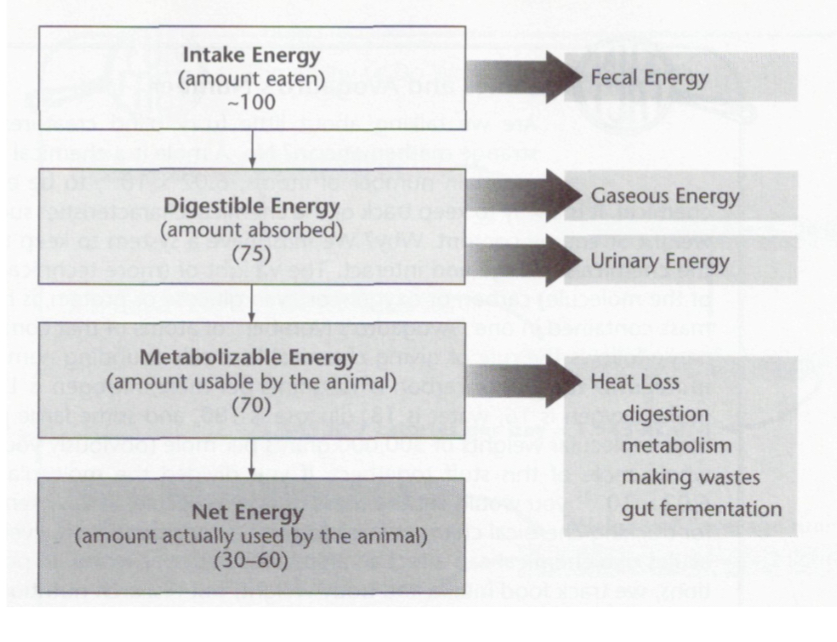
What is Intake Energy and what reduces it?
the amount of food eaten (~100), and it is reduced by fecal energy losses.
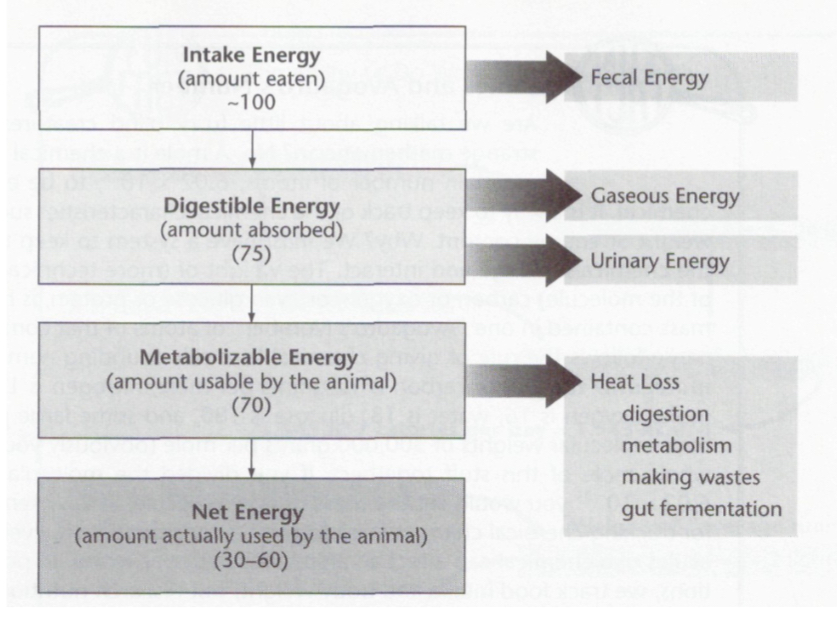
What is Digestible Energy and what reduces it?
the absorbed portion (~75), reduced by gaseous energy and urinary energy losses.
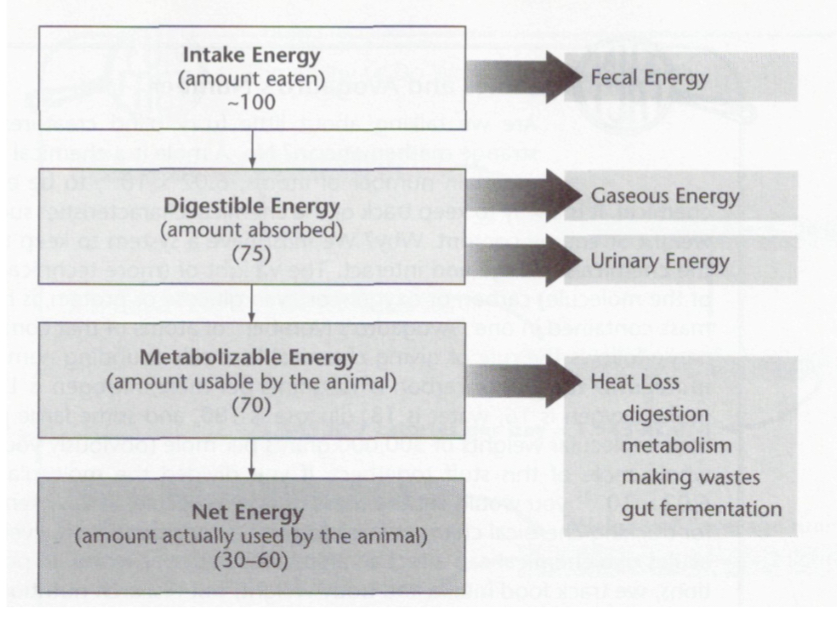
What is Metabolizable Energy and what reduces it?
the usable portion (~70), reduced by heat losses from digestion, metabolism, making wastes, and gut fermentation.
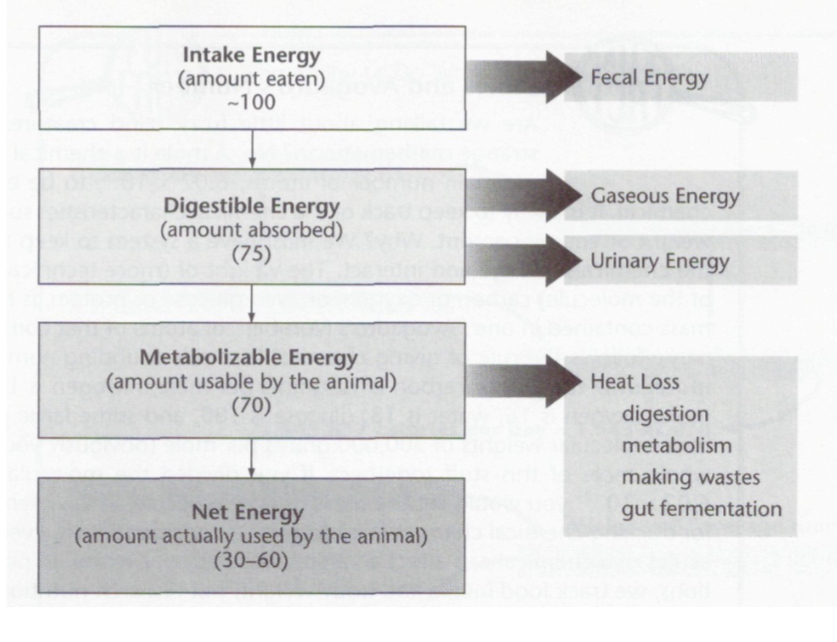
What is Net Energy?
the actual amount of energy available to the animal (30–60).
How is energy determined?
In calories
What is a calorie?
the amount of energy required to increase the
temperature of 1 gram of water 1^o Centigrade
What is direct calorimetry?
Measurement of the change in heat, usually of water, surrounding some heat generating body.
What is indirect calorimetry?
Uses our exact knowledge of chemical reactions to calculate the heat produced based on the amount of oxygen entering the body and the amount of carbon dioxide and urea leaving the body.
How do the laws of thermodynamics apply to metabolism?
Energy release from oxidation is the same whether in a bomb, fire, or metabolic pathway, so heat production can be estimated by measuring oxygen in or carbon dioxide out
How can we determine the energy retained by an animal?
By measuring food energy intake and subtracting energy lost in urine, feces, and heat, the difference shows the energy retained or lost by the body.
What is maintenance energy?
the energy used to stay alive with no change in body weight or composition, excluding growth, exercise, or reproduction.
What are the 3 functions maintenance energy varies with?
1) Cellular and organ function
2) Normal voluntary activity (like obtaining food) 3) Maintenance of body temperature.
What does maintenance energy consist of?
BMR+Voluntary Activity+Thermal Regulation
What is BMR?
the amount of metabolism that is minimal to keep
the animal alive with no change in body composition and running all basic bodily functions of involuntary muscular and neural activity.
What are the four basic conditions which must be met to measure BMR?
The animal must be at rest
The animal must be awake
There must be no nutrients being absorbed from the intestines (fasting)
Animals must be kept in their zone of thermoneutrality
What is Brown adipose tissue?
cells which have large numbers of mitochondria that are specialized to generate heat instead of ATP in the electron transport chain
What is metabolic body weight (MBW) and why is it used?
MBW accounts for differences in organ activity, since metabolically active organs (liver, intestines, heart, muscles) use more energy than bone, fat, or connective tissue, making body weight alone an inaccurate measure of energy use.
How is metabolic body weight (MBW) calculated?
Metabolic rate is estimated by raising body weight to the 0.75 power
Why is the concept of metabolic body weight (MBW) important?
Plotting basal metabolic rate against MBW gives a linear line, showing similar underlying biology across animals and allowing energy needs to be estimated from body size.
What is heat increment?
the energy given off as heat by the body
during normal digestion and metabolism of food over and above the energy retained by the body
The heat increment contains 4 sources. What are they?
Heat of digestion (chemical rxn’s in digestive tract)
Heat of fermentation (chemical rxn’s of the bacterial in digestive tract)
Heat of waste product formation (heat from making waste products)
Heat of nutrient metabolism (total heat from all other metabolic
reactions
What are Atwater’s Physiological Fuel
Values?
Carbohydrates – 4 kcal ME/gram
Proteins – 4 kcal ME/gram
Lipids – 9 kcal ME/gram
What is metabolism?
All chemical reactions in an organism.
What is catabolism?
The breakdown of organic substrates.
What is anabolism?
the synthesis of new organic molecules
What do glycogen store?
Glucose
What do triglycerides store?
lipids/fatty acids